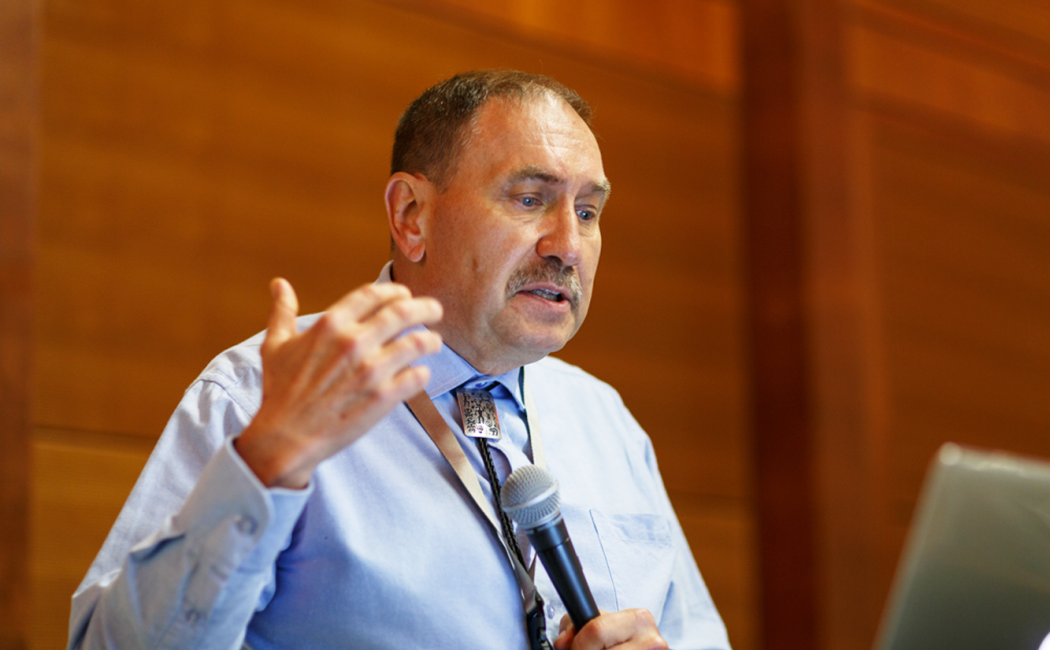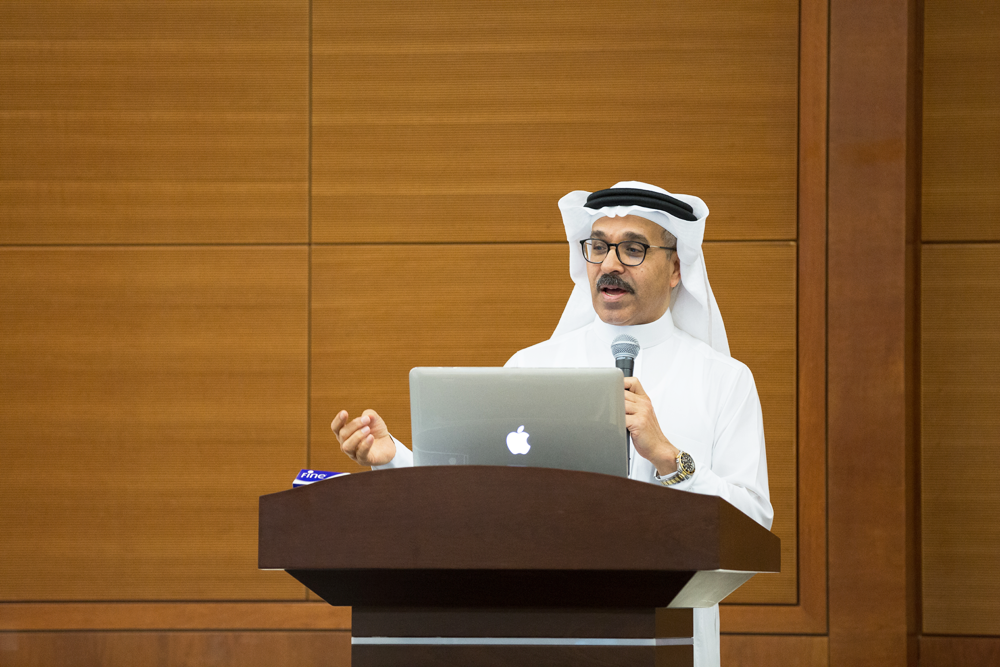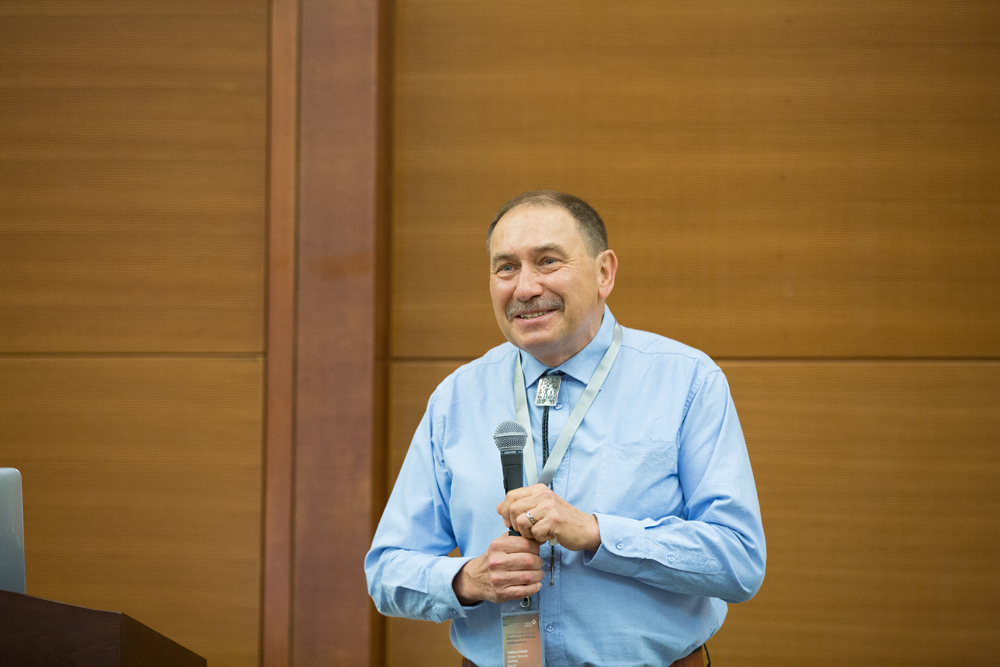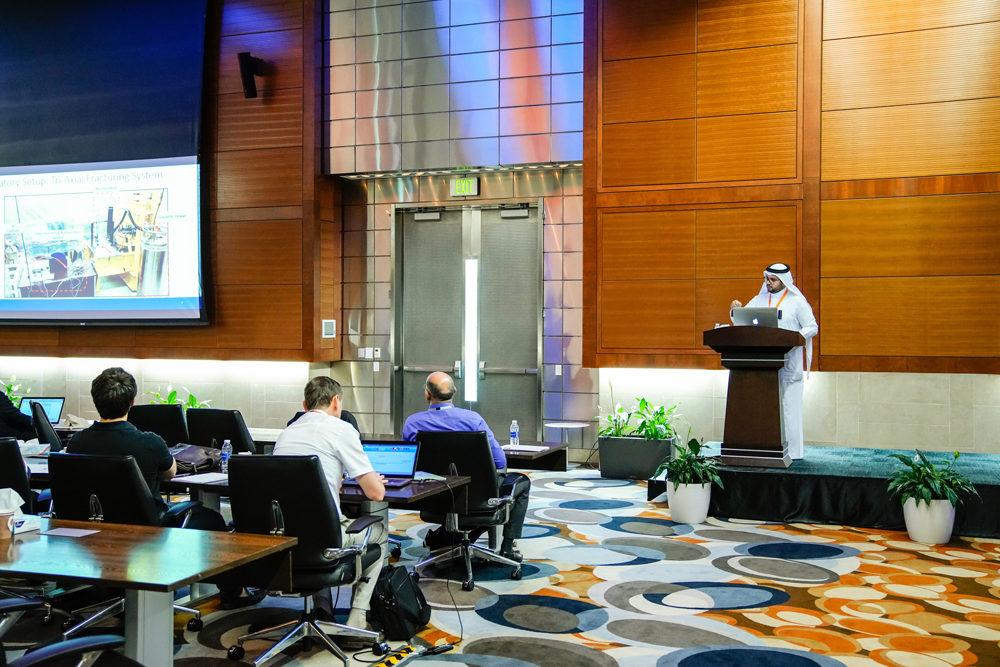.jpg?sfvrsn=39330263_0)
.jpg?sfvrsn=39330263_0)

26 March, 2018

 Abbas Firoozabadi, a professor at Yale University, spoke during the recent KAUST Research Conference: Recovery of Difficult Hydrocarbons. Photo by Asharaf Kannearil.
Abbas Firoozabadi, a professor at Yale University, spoke during the recent KAUST Research Conference: Recovery of Difficult Hydrocarbons. Photo by Asharaf Kannearil.-By David Murphy, KAUST News
Over the next 30 to 50 years, the oil and gas industry will face a number of challenges. Chief among these is the difficulty of meeting growing global hydrocarbon demand as energy and feedstock within 21st century constraints. The industry must achieve a balance between environmental sensitivities, market pressures and rising costs. Pressing questions arise when these dilemmas are addressed, such as: How can we recover more oil and gas from difficult carbonate reservoirs?; How can the hydrocarbon industry reach higher ultimate recoveries while limiting environmental impact?; And how can the industry keep profits high enough to ensure sufficient income for hydrocarbon-dependent economies?
During the recent KAUST Research Conference: Recovery of Difficult Hydrocarbons organized by the Ali I. Al-Naimi Petroleum Engineering Research Center (ANPERC), attendees wrestled with these and other questions. The conference, which was held from February 12 to 14, also examined technical solutions to enhance environmentally sound recovery from complex oil and gas fields at low cost within the Middle East.
The conference featured 39 presentations by renowned experts in industry and academia. It focused on improving the description, understanding and modeling of the storage and flow of hydrocarbons in the subsurface, including matrix storage and natural and artificial fractures and the impact of reservoir pressure changes. During the conference, various hydrocarbon research topics were covered, including multi-scale heterogeneous carbonate reservoirs; multi-scale imaging fractures; complex rock/fluid systems; oil and gas recovery; multiphase fluid flow in heterogeneous/fractured reservoirs; hydro-mechanical coupling; and modeling hydrocarbons.

 KAUST Interim President Nadhmi Al-Nasr opens the ANPERC Research Conference: Recovery of Difficult Hydrocarbons on the KAUST campus. Photo by Lilit Hovhannisyan.
KAUST Interim President Nadhmi Al-Nasr opens the ANPERC Research Conference: Recovery of Difficult Hydrocarbons on the KAUST campus. Photo by Lilit Hovhannisyan.
KAUST Interim President Nadhmi Al-Nasr opened the event by welcoming attendees and highlighting some of the unique aspects of the University and the rich hydrocarbon reserves in the Kingdom.
"We are excited at KAUST almost every day because something is always happening here. We wanted KAUST to be part of the world's thoughts. We are blessed as a country due to our reserves of hydrocarbons and we believe that KAUST will add value to the research and technology of future oil and gas exploration," Al-Nasr said.

 Director of the Ali I. Al-Naimi Petroleum Engineering Research Center and Professor of Earth Science and Engineering Tadeusz W. Patzek opens the Recovery of Difficult Hydrocarbons research conference on the KAUST campus. Photo by Lilit Hovhannisyan.
Director of the Ali I. Al-Naimi Petroleum Engineering Research Center and Professor of Earth Science and Engineering Tadeusz W. Patzek opens the Recovery of Difficult Hydrocarbons research conference on the KAUST campus. Photo by Lilit Hovhannisyan.
In his welcome address, Tadeusz Patzek, professor of earth science and engineering and the Director of ANPERC, touched on some of the issues facing the oil and gas industry.
"The story of our industry is that you have to run twice as fast to keep up with developments. Our industry is facing many challenges—we must be forward-thinking in our research," Patzek said.
Volker Vahrenkamp, KAUST professor of practice in earth science and engineering, expanded on Patzek's comment, adding, "In our industry, we may have to run twice as fast to keep up with developments, but we also have to keep our feet on the ground—that is where the hydrocarbons are located."
Manika Prasad, professor of petroleum engineering at the Colorado School of Mines, gave a presentation entitled "Shale Rock Physics: Understanding Storage Capacity, Permeability and Poroelasticity in Complex Reservoirs." Prasad discussed the effects of fluid polarity and rock mineralogy on pore size distribution and their use in existing models. Her talk focused on the common links between petrophysical and geophysical properties as observed in studying the physics and rock mechanics of tight reservoirs.
"In our lab, we have a multi-physics approach, which helps assign and constrain causative mechanisms for rock physics models. Pore compliance is commonly the main cause of pressure sensitivity. Pore-cluster compliance helps to better explain pressure-dependent changes," Prasad said.
Following on from Prasad, Sotirios Kokkalas, an associate professor of petroleum geoscience at Khalifa University of Science and Technology in Abu Dhabi, UAE, covered digital technologies for characterization of fracture networks in reservoir 3-D outcrop analogs. Kokkalas presented results from his team's findings on the pore pressure oscillation method coupled with deformation and seismic velocity measurements to document changes in poroelastic properties and storage capacity at various stress conditions.
"We've had some real hands-and-knees fieldwork related to our studies—fracture parameters, which are difficult or impossible to quantify in subsurface data. Identifying and mapping the properties and distribution of reservoir fracture systems in order to evaluate reservoir quality and model performance has been one of the biggest challenges. Gathering data using a variety of methods across a wide range of scales is possible," Kokkalas pointed out.

 Chi Zhang, assistant professor of geology at the University of Kansas, addressed attendees during the recent KAUST Research Conference: Recovery of Difficult Hydrocarbons. Photo by Asharaf Kannearil.
Chi Zhang, assistant professor of geology at the University of Kansas, addressed attendees during the recent KAUST Research Conference: Recovery of Difficult Hydrocarbons. Photo by Asharaf Kannearil.
Michael Behm, assistant professor of geology and geophysics at the University of Oklahoma, explained how seismic monitoring is a potential tool for monitoring sub-surface effects related to water injection when tracking water migration paths during oil recovery (by flooding). In a presentation entitled "Application of Microseismic Monitoring and Ambient Noise Interferometry for Improved Oil Recovery," Behm presented his team's research, which provides fresh insights into potential water paths, and concluded that borehole seismic monitoring appears as a promising and useful technique for steering water injection.
"We are trying to figure out whether microseismic monitoring can be used to map water flow paths—water flooding leads to increased pore pressure," Behm noted. "Reactivation of existing natural fractures and induced hydraulic fracturing cause microseismic events. Seismic interferometry is very sensitive to small-medium velocity changes. You can get seismic ambient energy from traffic, drilling, surface facilities, earthquakes and ocean/seafloor interaction."

 Naif Alqahtani, an assistant research professor at the National Center for Oil and Gas Technology at the King Abdulaziz City for Science and Technology (KACST), gave a lecture during the recent on campus KAUST Research Conference: Recovery of Difficult Hydrocarbons. Photo by Asharaf Kannearil.
Naif Alqahtani, an assistant research professor at the National Center for Oil and Gas Technology at the King Abdulaziz City for Science and Technology (KACST), gave a lecture during the recent on campus KAUST Research Conference: Recovery of Difficult Hydrocarbons. Photo by Asharaf Kannearil.
"Decisions don't wait for the perfect data set. No matter what we do...we deal with a field of uncertainty, and no matter how good our data set is, remember—it's far from being perfect," Ghorayeb said.
"Our research team wants to increase recovery while minimizing the number of wells. We also want to assess the uncertainty associated with the fracture system. It is crucial to build multiple subsurface realizations covering fracture uncertainty," he added.

 H.E. Ali Al-Naimi answers questions from KAUST students during his KAUST Research Conference: Recovery of Difficult Hydrocarbons keynote presentation on February 12. Photo by Lilit Hovhannisyan.
H.E. Ali Al-Naimi answers questions from KAUST students during his KAUST Research Conference: Recovery of Difficult Hydrocarbons keynote presentation on February 12. Photo by Lilit Hovhannisyan.
One special highlight of the conference was the gracious participation of H.E. Ali I. Al-Naimi, the former Minister of Petroleum and Mineral Resources for the Kingdom of Saudi Arabia and the former president and CEO of Saudi Aramco. Al-Naimi hosted a special session with graduate students, during which he shared his unique insights and stories about his rise through the ranks of Saudi Aramco, his appointment by King Fahd as Minister of Petroleum and Mineral Resources and the founding of KAUST. During a friendly and engaging series of questions by Earth science and engineering students, Al-Naimi offered his best advice for young engineers just starting out in the world: "Always work hard and always seek the truth." \

 H.E. Ali Al-Naimi answers questions from KAUST students during his KAUST Research Conference: Recovery of Difficult Hydrocarbons keynote presentation on February 12. Photo by Lilit Hovhannisyan.
H.E. Ali Al-Naimi answers questions from KAUST students during his KAUST Research Conference: Recovery of Difficult Hydrocarbons keynote presentation on February 12. Photo by Lilit Hovhannisyan.
Al-Naimi also made the keynote presentation during the conference's gala dinner, which was held on the first night of the conference.